
From acai to endives, poke to paella, culinary jargon can get pretty complicated. And as the public gets ever more foodie, you've probably noticed more of these intimidating terms appearing on menus in recent years. In some cases, familiar items have been bestowed new names to appeal to diners' sense of sophistication. After all, "haricots verts" sounds a lot more appetizing – and expensive – than green beans.
But do these differences in presentation actually affect what we order? In this project, we conducted our own experiment in how dish descriptions alter what we choose to eat and how much we'll pay to do so. We surveyed 600 individuals about theoretical menu items, assessing how jargon shaped what they would spend. We gave 300 respondents a "descriptive" menu with buzzwords and phrases added to the dishes (e.g., "Grandma's Chicken Soup") and 300 other respondents a menu with the same dishes without the descriptive words ("Chicken Soup"). We also probed which other factors influenced what they would order, from sustainability sourcing to calorie counts. To find out how people really make their menu selections, keep reading.
Additive Adjectives
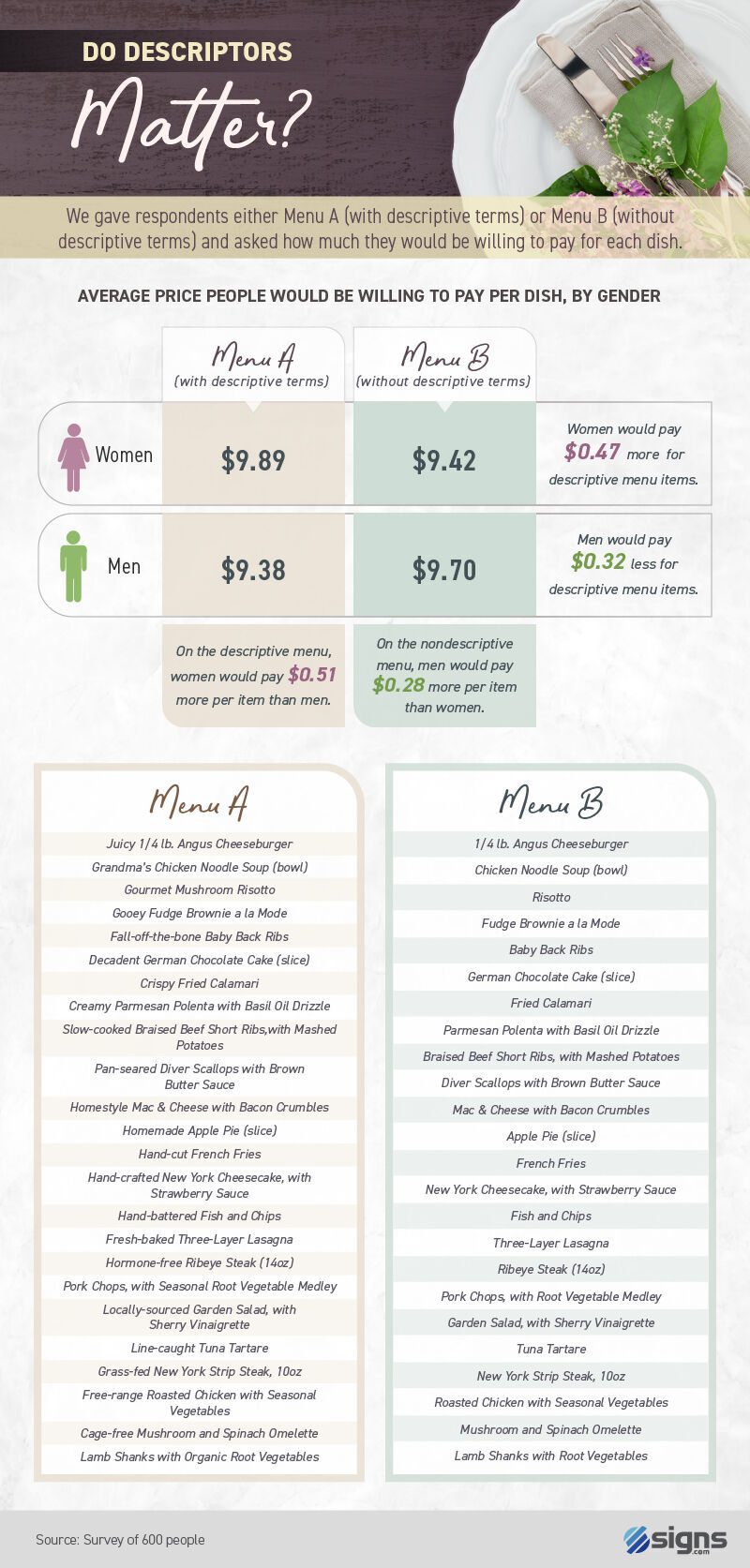
Above, you can compare the minimalist menu to the embellished alternative. In some cases, such as "locally sourced" or "hormone-free," the adjectives applied connote real differences in quality. In others, descriptors are merely intended to be enticing ("juicy" or "gooey"), or to describte the method of preparation("hand-made"). Cumulatively, however, our findings suggest additional descriptions are far more persuasive to women than men. Indeed, female respondents would pay 47 cents more for items on the descriptive menu than the straightforward one.
Conversely, men would pay 32 cents less on average for items on the menu that used more descriptive language. This result might seem to resonate with old tropes about how women and men use language differently, with men preferring more direct forms of speech. But recent linguistic research does not support this notion: It's impossible to make broad generalizations about the language each gender uses or finds persuasive. So we took a closer look at each menu item to see where the perceptions of men and women diverge.
Dishes, Descriptions, and Dollars
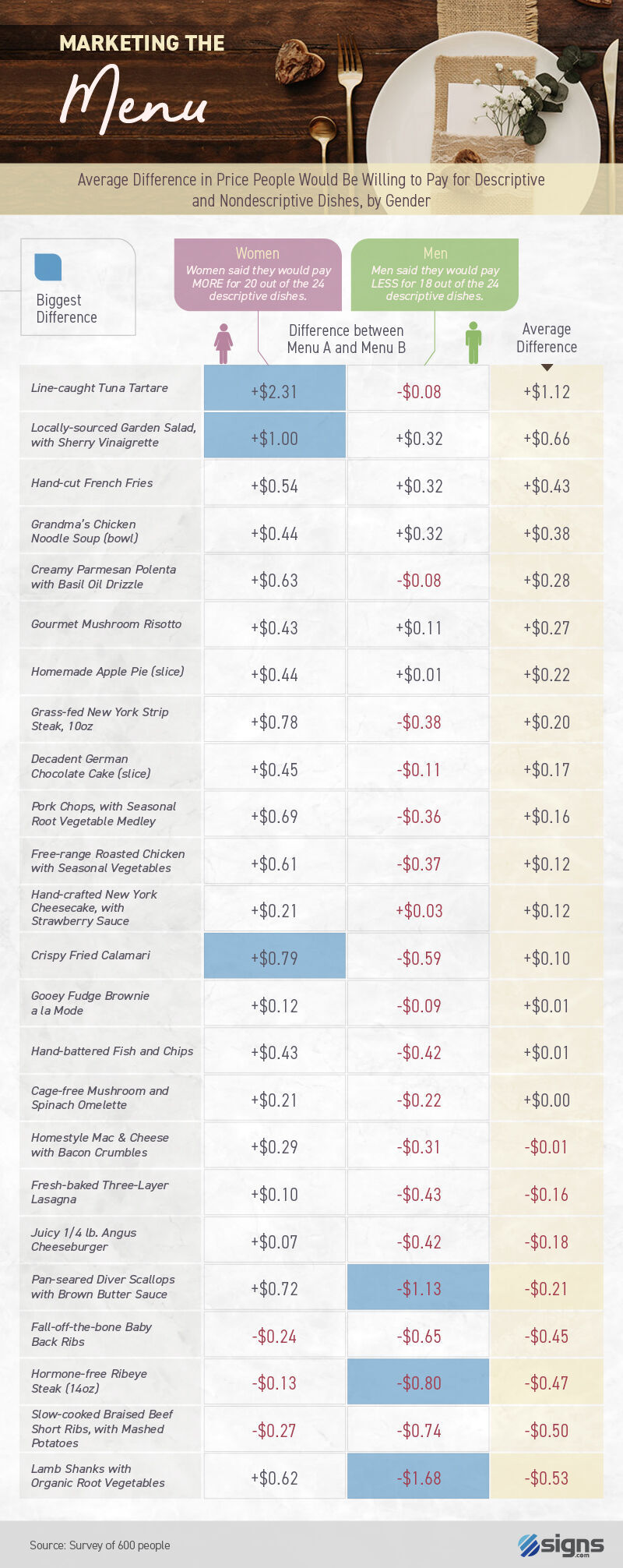
Men and women responded quite differently to fanciful dish descriptions, but some of the most interesting differences emerged regarding language about the capture or treatment of animals. In one striking example, women were willing to pay $2.30 more, on average, for "line-caught" tuna tartare. Men, meanwhile, said they'd pay 8 cents less for the dish with that designation added. Similarly, women were willing to pay more for grass-fed steak, free-range chicken, and cage-free eggs. In each of these instances, men said they'd pay less for the dish in question. This finding may relate to past studies suggesting women feel more empathy toward animals in peril.
Additionally, men seemed less impressed by adjectives and descriptors used in meat dishes. Although they would pay more for some items, like a line-caught tuna tartare and hand-cut french fries, they said they would pay significantly less for all the meat dishes we asked about. While this is certainly an indication of resistance toward any descriptive words on menus, perhaps the chasm can be linked to men's perceived expertise about cooking meat. After all, it's harder to justify spending on something you can do better yourself.
Menu Motives
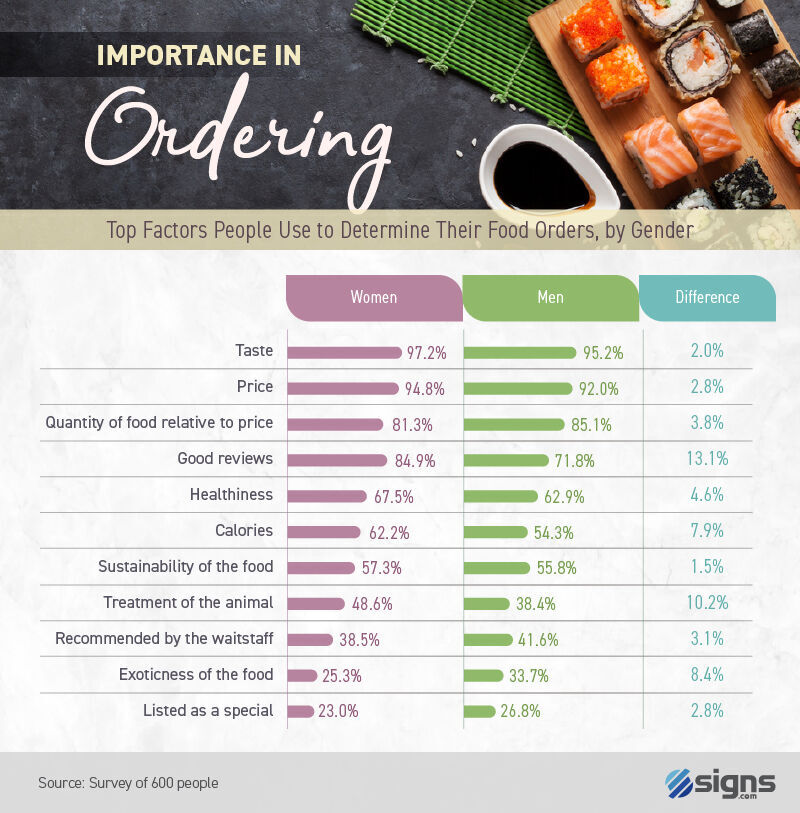
Our results suggest food descriptions can affect our perceptions of fair pricing – and much of this linguistic influence is likely subconscious. But we also asked our respondents which factors they consciously considered when ordering food. Taste was the factor selected by the greatest portion of men and women, followed closely by price. As Americans are eating out more often than in years past, cost is clearly a significant concern: You have to budget carefully if you plan to eat out daily. The quantity of food relative to the price was also a top factor, but to a slightly greater extent for men, who typically consume more food.
In keeping with our earlier results, women were much more likely to care about the treatment of the animal in question. A larger portion of female respondents also took reviews into account when making their menu selections. Men, by contrast, were more likely to take their cues from the restaurant and its staff. Men were slightly more willing to trust the recommendations of their waiters or go with an item listed as a special. Men were also more likely to choose a dish based on the exoticness of the food. Perhaps this speaks to more adventurous eating, though it also may indicate that men tend to eat, partially, out of ego, opting for "fancier" experiences.
Speaking of Sourcing
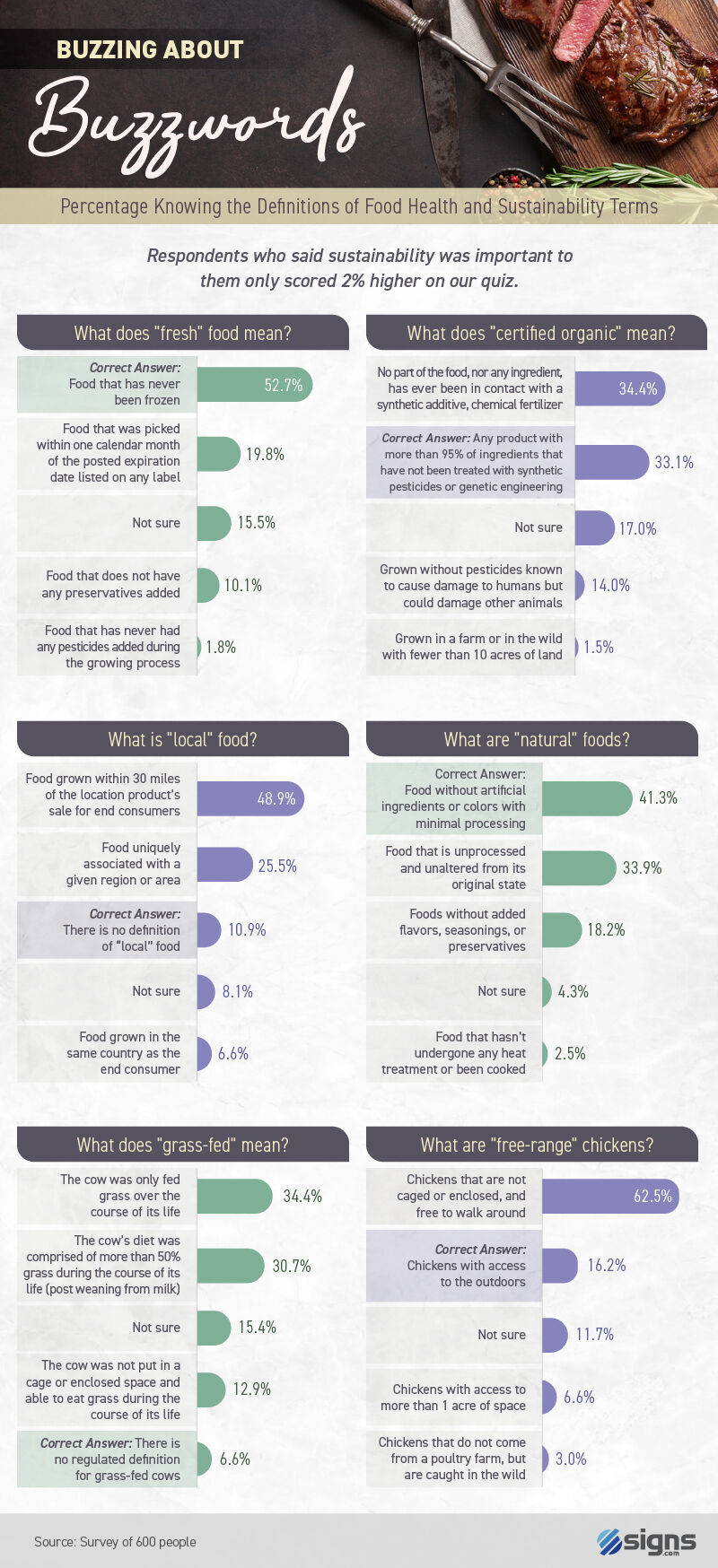
Sustainable and ethical sourcing may fetch a higher price from some consumers, but do they actually understand what various labels describe? In nearly every case, the vast majority of respondents could not correctly identify the standard necessary to earn each label. Confusion was particularly common with regard to the treatment of livestock. Just 6.6 percent of respondents knew what "grass-fed" signified, and 16.2 percent guessed what "free-range" really meant. Despite this apparent consumer uncertainty, meat bearing these labels can command much higher prices, causing more farmers to raise their livestock in these ways.
Respondents were slightly more informed about the "fresh" and "natural" designations, with at least 40 percent picking the correct definition for those terms. The definition of the "certified organic" label was also familiar to about a third of individuals. Interestingly, those who professed concern about the environment weren't particularly well-informed about such labels. People who said sustainability was important to them scored only 2 percent higher, on average, on this quiz.
Pictures and Pronunciation
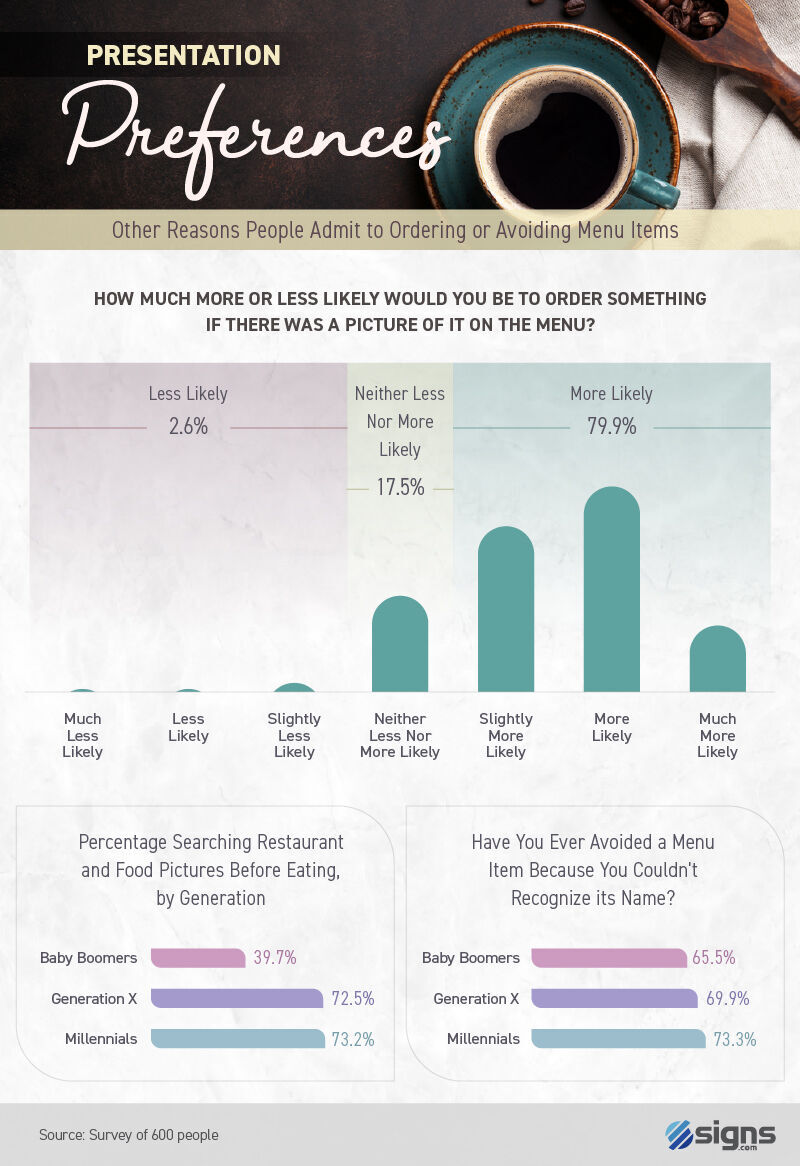
If a menu's language can sway customers, can images do the same? Roughly 4 in 5 respondents said a picture of an item would increase the chances they'd order it, and less than 3 percent said it would make them less likely to do so. There's an appealing sense of safety in knowing what your meal will look like in advance, but this trend may have something to do with social media as well. Many diners are eager to Instagram their meals, so it may help to know your food will be photogenic ahead of time.
Most Gen Xers and millennials also looked for photo evidence elsewhere, searching for images of restaurants and their menu items online before eating. Baby boomers were far less likely to do so, however, and were also less willing to be deterred by tough menu terms. Millennials were the most likely generation to avoid menu items they couldn't pronounce. The reason for this is unknown, but we wouldn't discount the fear of looking unsophisticated in front of a waiter or date as a potential reason.
Caloric Concerns
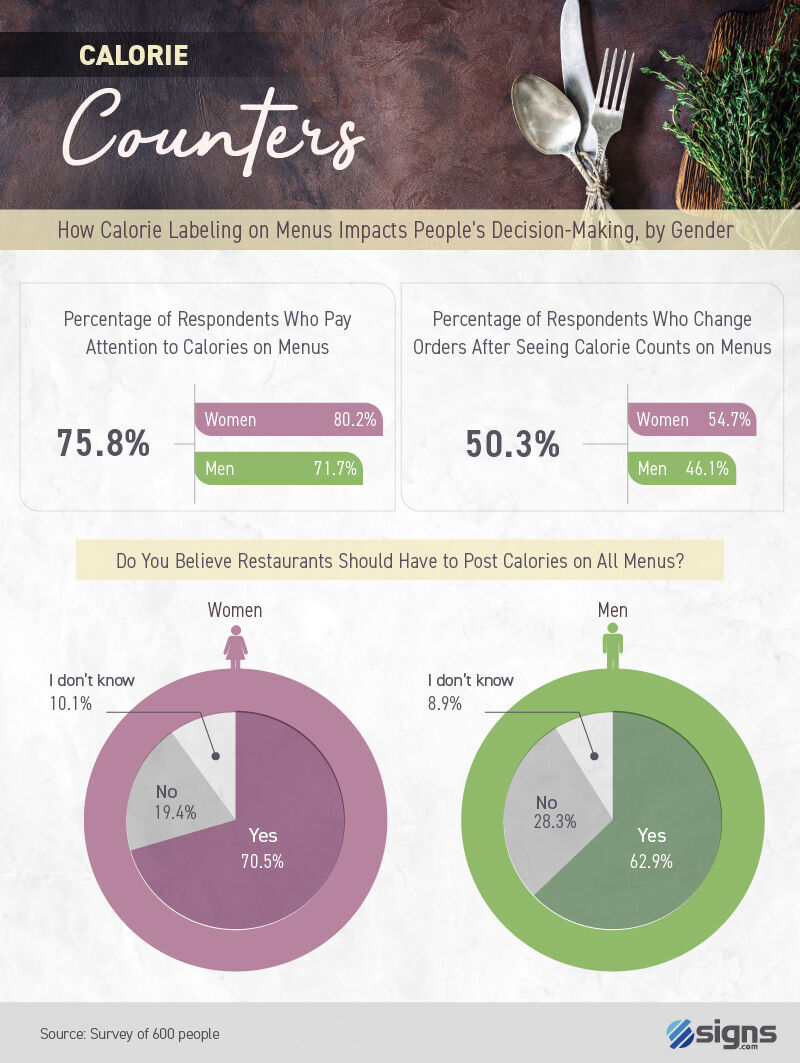
Chain restaurants are now required to post calorie counts on their menus, and our findings suggest most people care about the number beside each item. Women were slightly more likely to care about calorie counts than were men and also more likely to change what they would otherwise order after seeing the calorie figures. Interestingly, men are actually more likely to be overweight or obese and thus have reason to scrutinize their calorie consumption.
Most nutrition experts feel calorie information can only help consumers make better choices, especially because people struggle to assess how many calories they're consuming otherwise. In that spirit, nearly 63 percent of men and over 70 percent of women felt all restaurants should be required to include calorie counts on their menus. A significant number opposed such a measure, however; perhaps they want to indulge without guilt-inducing statistics on occasion.
Communicating Cuisine
If our results are any indication, presentation can significantly affect the way we place our orders – even if we're fuzzy about what the terms on our menus actually mean. But however restaurants choose to describe what they serve, the true test comes once the food arrives. As our findings suggest, taste and price still rule supreme in matters of menu selection. Customers may be fooled once by fancy jargon, but if the grub fails to live up to the lingo, a repeat order seems unlikely. In an age where anyone can be a critic online, you'll need to deliver to keep diners coming.
Methodology
To compile the data for this project, we surveyed 600 people on their food preferences. We ran two surveys, with 300 respondents each, who got either Menu A (the descriptive menu) or Menu B (the nondescriptive menu) and asked how much people would pay for certain dishes. We launched the surveys on consecutive days at the same time to reduce "hungry while grocery shopping and buying the whole store" bias. We asked each group the identical series of questions on each menu and about menu behaviors generally.
About Signs.com
Before proving worthy of customers' loyalty, restaurants need to get patrons in the door. At Signs.com, our team specializes in custom signage that does exactly that. From statement-making banners to customized decals, we'll help you build the buzz your business deserves.
Fair Use Statement
Unlike buffets and stuffy restaurants, we encourage sharing for noncommercial purposes – at no extra charge! If you do use our content on your own site or social channels, simply attribute us with a link back to this page.


 Fastest Growing Private Companies in America
Fastest Growing Private Companies in America